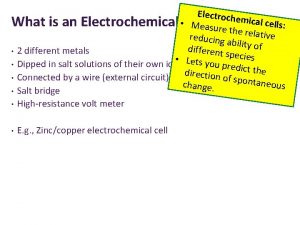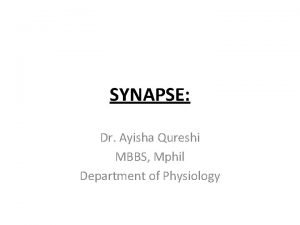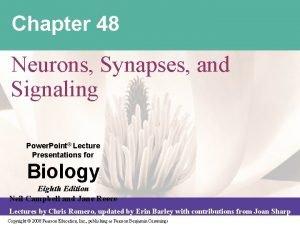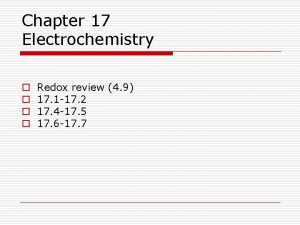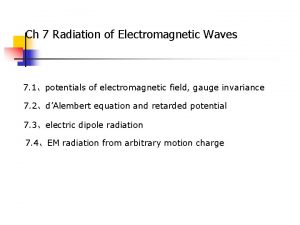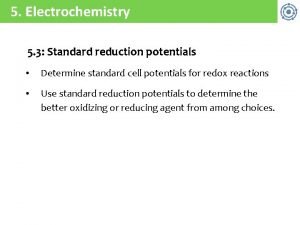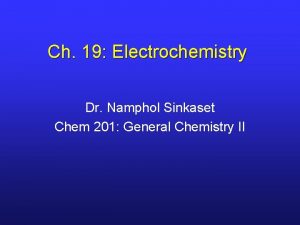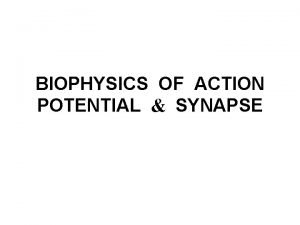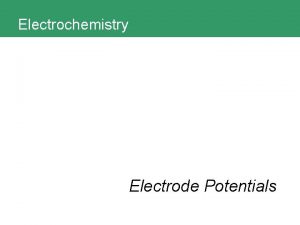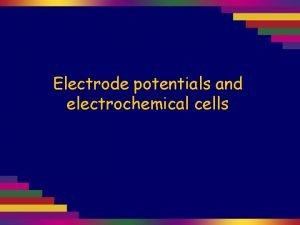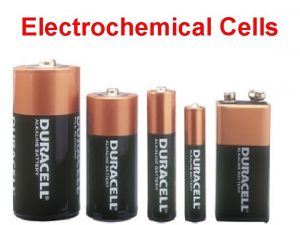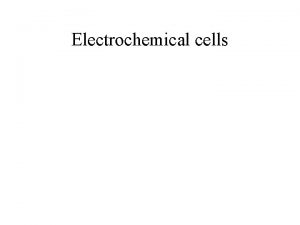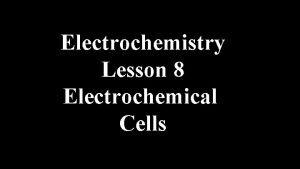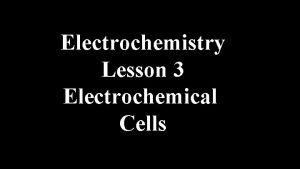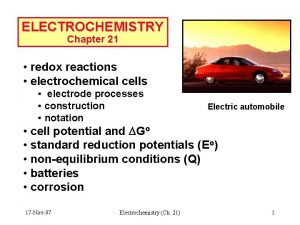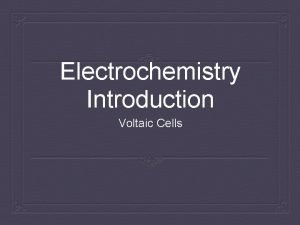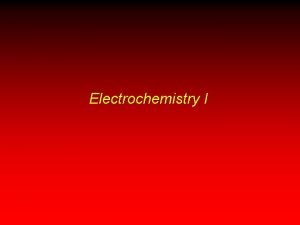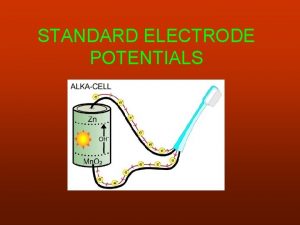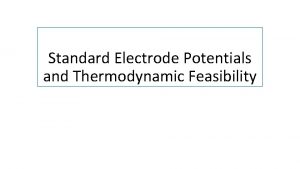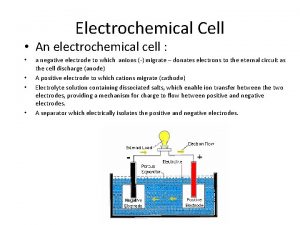Section 10 Electrochemical Cells and Electrode Potentials Electrochemistry














- Slides: 14

Section 10 Electrochemical Cells and Electrode Potentials

Electrochemistry Oxidation/Reduction Reactions • “Redox” reactions involve electron transfer from one species to another • Ox 1 + Red 2 Red 1 + Ox 2 • Ox 1 + ne- Red 1 (Reduction ½ reaction) • Red 2 Ox 2 + ne- (Oxidation ½ reaction) • “Reducing agent” donates electrons (is oxidezed) • “Oxidizing agent” accepts electrons (is reduced)

Electrochemistry Oxidation/Reduction Reactions • Typical oxidizing agents: Standard Potentials, V – O 2 + 4 H+ + 4 e- 2 H 2 O +1. 229 – Ce 4+ + e- Ce 3+ +1. 6 (acid) – Mn. O 4 - + 8 H+ + 5 e- Mn 2+ + 4 H 2 O +1. 51 • Typical reducing agents: – Zn 2+ + 2 e- Zno – Cr 3+ + e- Cr 2+ – Na+ + e- Nao -0. 763 -0. 408 -2. 714

The salt bridge allows charge transfer through the solution and prevents mixing. The spontaneous cell reaction (Fe 2+ + Ce 4+ = Fe 3+ + Ce 4+) generates the cell potential. The cell potential depends on the half-reaction potentials at each electrode. The Nernst equation describes the concentration dependence. A battery is a voltaic cell. It goes dead when the reaction is complete (Ecell = 0). Fig. 12. 1. Voltaic cell. ©Gary Christian, Analytical Chemistry, 6 th Ed. (Wiley)

Electrochemistry Standard Reduction Potentials • • • Half-Reaction Potentials: They are measured relative to each other Reference reduction half-reaction: standard hydrogen electrode (SHE) normal hydrogen electrode (NHE) 2 H+(a=1. 0) + 2 e- H 2(g 1 atm) 0. 0000 volts

The more positive the Eo, the better oxidizing agent is the oxidized form (e. g. , Mn. O 4 -). The more negative the Eo, the better reducing agent is the reduced form (e. g. , Zn). ©Gary Christian, Analytical Chemistry, 6 th Ed. (Wiley)

Electrochemistry Reduction Potentials • General Conclusions: • 1. The more positive the electrode potential, the stronger an oxidizing agent the oxidized form is and the weaker a reducing agent the reduced form is • 2. The more negative the reduction potential, the weaker the oxidizing agent is the oxidized formis and the stronger the reducing agent the reduced form is.

Electrochemistry Oxidation/Reduction Reactions • Typical oxidizing agents: Standard Potentials, V – O 2 + 4 H+ + 4 e- 2 H 2 O +1. 229 – Ce 4+ + e- Ce 3+ +1. 6 (acid) – Mn. O 4 - + 8 H+ + 5 e- Mn 2+ + 4 H 2 O +1. 51 • Typical reducing agents: – Zn 2+ + 2 e- Zno – Cr 3+ + e- Cr 2+ – Na+ + e- Nao -0. 763 -0. 408 -2. 714

Electrochemistry Oxidation/Reduction Reactions • • • Net Redox Reactions: Standard Potentials, V Mn. O 4 - Mn 2+ Mn. O 4 - + 8 H+ + 5 e- Mn 2+ + 4 H 2 O +1. 51 Sn 4+ + 2 e- Sn 2+ +0. 154 Balanced Net Ionic Reaction: • 2 Mn. O 4 - + 16 H+ + 5 Sn 2+ 2 Mn 2+ + 5 Sn 4+ + 8 H 2 O

Electrochemistry Voltaic Cell • The spontaneous (Voltaic) cell reaction is the one that gives a positive cell voltage when subtracting one halfreaction from the other. • Eocell = Eoright – Eoleft = Eocathode – Eoanode =Eo+ - Eo • Which is the Anode? The Cathode? • Convention: • The anode is the electrode where oxidation occurs the more negative half-reaction potential • The cathode is the electrode where reduction occurs the more positive half-reaction potential • anode solution cathode

Electrochemistry Oxidation/Reduction Reactions • • • Net Redox Reactions: Standard Potentials, V Mn. O 4 - Mn 2+ Mn. O 4 - + 8 H+ + 5 e- Mn 2+ + 4 H 2 O +1. 51 Sn 4+ + 2 e- Sn 2+ +0. 154 Balanced Net Ionic Reaction: • 2 Mn. O 4 - + 16 H+ + 5 Sn 2+ 2 Mn 2+ + 5 Sn 4+ + 8 H 2 O • Eocell = Eocat – Eoan = (+1. 51 – (+0. 154)) = +1. 36 V

Electrochemistry Nernst Equation • Effects of Concentrations on Potentials: • a. Ox + ne- b. Red • E = Eo – (2. 3026 RT/n. F) log([Red]b/[Ox]a – Where E is the reduction at specific conc. , – Eo is standard reduction potential, n is number of electrons involved in the half reaction, – R is the gas constant (8. 3143 V coul deg-1 mol-1), – T is absolute temperature, – and F is the Faraday constant (96487 coul eq-1). • At 25 o. C(298. 16 K) the value of 2. 3026 RT/F is 0. 05916 • Note: Concentrations should be activities

Electrochemistry • Calculations: • • • Mn. O 4 - + 8 H+ + 5 e- Mn 2+ + 4 H 2 O Eo = +1. 51 V For [H+] = 1. 0 M, [Mn. O 4 -] = 0. 10 M, [Mn 2+] = 0. 010 M E = Eo – 0. 05916/5 (log ([Mn 2+]/[Mn. O 4 -][H+]8) E = +1. 51 – 0. 1183(-1) = +1. 63 V vs NHE Note: This is more positive than Eo Greater tendency to be reduced compared to standard conditions.

Electrochemistry • Calculations: • • Silver electrode/silver chloride deposit/0. 010 M Na. Cl Ag. Cl + 1 e- Ago + Cl. E=? Ag+ + 1 e- Ago Eo = +0. 799 V Ag. Cl Ag+ + Cl. Ksp= 1. 8 x 10 -10 Ag. Cl + e- Ago + Cl. E = Eo - (0. 05916/1) Log (1/[Ag+]) [Ag+] = Ksp/[Cl-] = 1. 8 x 10 -10/(0. 010) = 1. 8 x 10 -8 E = +0. 799 – (0. 05916)(7. 74) = +0. 341 V
 Eθcell
Eθcell Paranasal sinus at birth
Paranasal sinus at birth Red blood cells and white blood cells difference
Red blood cells and white blood cells difference Plant cell vs animal cell venn diagram
Plant cell vs animal cell venn diagram Masses of cells form and steal nutrients from healthy cells
Masses of cells form and steal nutrients from healthy cells Function of synapse
Function of synapse Source of bioelectric potential
Source of bioelectric potential Graded potentials
Graded potentials Graded potential vs action potential
Graded potential vs action potential Postsynaptic potentials
Postsynaptic potentials Table of standard reduction potentials
Table of standard reduction potentials Multiple expansion
Multiple expansion Standard cell potentials
Standard cell potentials Use the tabulated half-cell potentials to calculate
Use the tabulated half-cell potentials to calculate Summation of postsynaptic potentials
Summation of postsynaptic potentials
